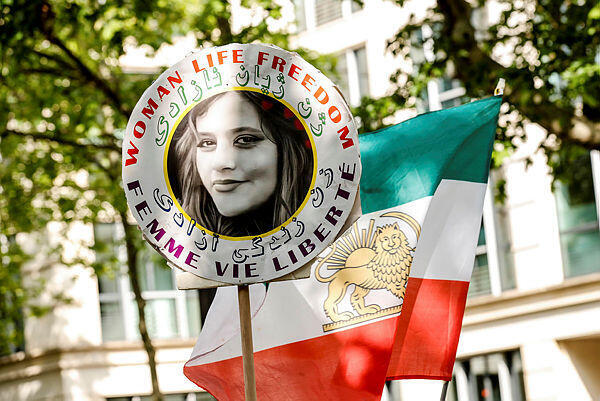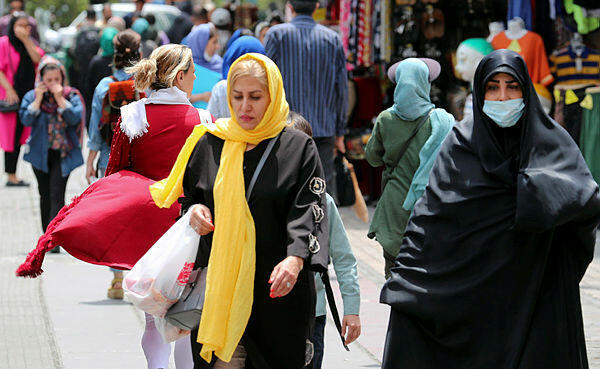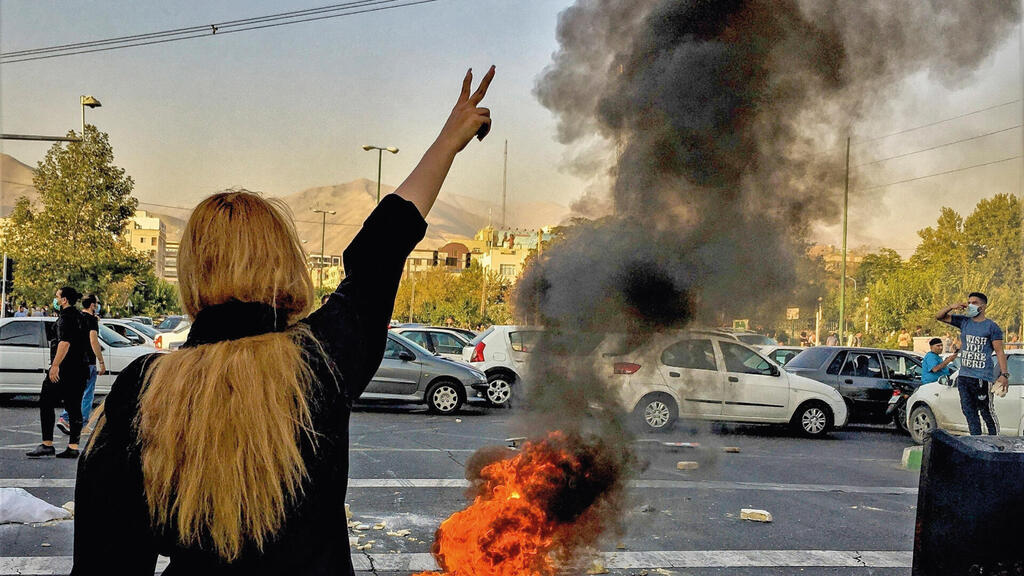Getting your Trinity Audio player ready...
Iran’s economic crisis is far more severe than previously thought, a recent report in the Persian-language media reveals, shedding new light on the profound challenges the Islamic Republic is facing.
The report, titled “The actual budget deficit in Iran’s economy” reveals that the Iranian government is grappling with a budget deficit of 794 trillion tomans, which is approximately $18 billion based on the current exchange rate of 42,000 tomans per $1.
3 View gallery


A demonstrator carries the portrait of Mahsa Amini, who died in detention following her arrest by the Iranian morality police in September 2022
(Photo: Teresa Suarez)
Furthermore, the report states that the government’s debt is an astounding three quadrillion tomans, equivalent to $71 billion, approximately 31% of Iran’s gross domestic product.
This debt encompasses obligations to various Iranian entities such as banks, the Central Bank of Iran (CBI), pension and social security funds, public and private sector contractors, as well as outstanding bonds. Additionally, the government owes about $74 billion to the National Development Fund.
Iran also is facing rising inflation rates, which the government has attempted to conceal. Reports suggest that the inflation rate in Iran has reached 70%, the highest inflation rate in the last 30 years. This unprecedented surge is driven by an unstoppable decline in the value of the national currency, the rial.
Moreover, the government’s projected budget for the current year is estimated at “five million billion” tomans, a sum that is difficult to fathom. Economists believe that the government would never be able to earn such a huge amount of income, even if the US sanctions on the regime are lifted.
According to the April report published by the International Monetary Fund (IMF), the economic challenges that Iran is facing can only be overcome if the regime is able to sell oil at a price of $351.7 per barrel. However, this scenario is deemed impossible to achieve given the low price of oil in international markets.
In such a dire economic situation, the government will likely find it challenging to continue providing cash subsidies (known as yaraneh) to the poor people. Rahim Mombeini, the deputy head of Iran’s Planning and Budget Organization, stated that the government would be unable to fulfill its promise of distributing yaraneh to the needy.
This is due to a significant deficit of 190 thousand billion Iranian tomans in the budget allocated specifically for this purpose.
The Iranian regime is also confronted with some other challenges including the nation’s growing frustration over social disparities. As a result, the prospect of a new wave of civic rebellions against the regime seems increasingly inevitable.
Mohammad Mohajeri, the editor of Khabar Online, an outlet aligned with regime hard liners, argues that the regime should anticipate a fresh wave of nationwide unrest unless substantial measures are taken to address underlying societal fractures.
Mohajeri likens social unrest in Iran to an earthquake: its occurrence may be unavoidable, but the damage can be mitigated with certain measures. These include implementing reforms and policy adjustments, addressing the grievances of the people, and abandoning repressive tactics to suppress unrest.
During the recent protests, sparked by the death of Mahsa Amini, the regime resorted to overwhelming violence in an attempt to quell the demonstrations. This resulted in the death of over 530 protesters, including 72 children.
Furthermore, security forces arrested over 29,688 participants and executed dozens in gruesome public displays, aimed at intimidating people and discouraging participation in future uprisings.
While protests may have diminished, signs of public dissatisfaction remain evident. Iranian women continue to defiantly challenge the regime, resisting the discriminatory hijab law in spite of the regime's brutal crackdown.
Various protests have unfolded at universities across Tehran and other provinces, where they chanted “Woman, life, freedom” and “Death to the dictator.” Workers’ strikes across key industries such as energy, petrochemicals and steel are growing.
3 View gallery


Iranian women, wearing veils, walk among other pedestrians along a street in Tehran, Iran, on May 22, 2023
(Photo: Abedin Taherkenareh )
Additionally, new sectors like education and transportation, specifically teachers, pensioners and truck drivers are joining the nationwide industrial action because their payments cannot keep up with rampant inflation and the massive increase in the price of food.
Strong economic undercurrents, growing dissatisfaction among Iranians, and a legitimacy crisis have created a virtual Bermuda Triangle for the regime, nearly impossible to escape without a radical shift in both domestic and foreign policies.
Yet, such a shift appears unlikely as long as the Islamic Republic, under the leadership of Ayatollah Ali Khamenei, remains dedicated to its revolutionary principles. These principles demand the diversion of vast resources from the domestic sphere, where they are desperately needed, toward consolidating influence over other peoples and territories.
This situation necessitates outside intervention to support the Iranian people in their struggle against the oppressive Islamic Republic. More crippling economic sanctions targeting the regime leaders could further limit their access to resources, making it harder for them to maintain power. Imposing severe sanctions and applying political pressure could coerce the regime into halting its brutal treatment of citizens, particularly young women.


